Outdoor sewage: how to quickly and inexpensively build a
The system of removal of sewage from a private residential building, in contrast to an apartment, consists of three main elements. One of them is outdoor sewage. Despite its apparent simplicity, the instruction for laying the external pipeline has many nuances and features, which will be discussed below.
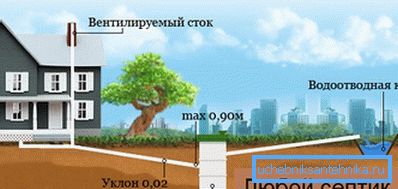
Materials used
Before starting installation of the external sewage system, it is necessary to determine the material from which the necessary sewer pipes, fittings and fittings are made.
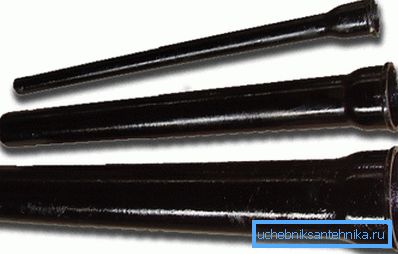
Currently applied:
- cast iron - pipes weigh quite a lot, have a rough internal surface, which contributes to the formation of sewer blockages, and for installation require the use of specialized engineering equipment;
- concrete - massive structures, which are rarely used for the construction of individual external sewer networks;
- ceramics - A good option, but the products are too fragile and can be damaged in the process of laying;
- asbestos cement - pipes made of it are also quite fragile and have practically not been used recently due to the appearance of more modern materials;
- plastic;
- fiberglass.

Plastic is particularly popular.
Such pipes and fittings:
- have a small weight;
- have good strength;
- resistant to chemicals;
- for installation do not require special equipment;
- smooth inner surface prevents clogging;
- the material is able to withstand low ambient temperatures.
As for fiberglass, the device external sewage of this material is also possible, but the price of such parts will be much higher.
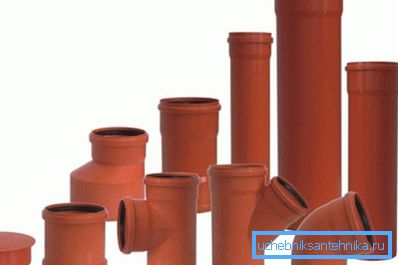
There are several types of plastic pipes:
- polypropylene;
- polyethylene;
- polyethylene chloride - the best option, because it can withstand low ambient air temperature and high - flowing through them liquid.
Tip! For installation of the sewer pipeline connecting the internal sewer with a septic tank, it is enough to use plastic products with a diameter of 110 mm. In the case when the pipe will be exposed to external loads, purchase two-layer corrugated parts.
An estimate of the cost of purchased materials and installation services will be very useful. Some of the work it provides can be done independently, which will save you money.
Assembly process
Requirements of regulatory documents
When creating the considered engineering network, it is necessary to adhere to certain standards fixed by the relevant documents. SNiP on the external water supply and sewage of buildings have the number 3.02.01-87.
Consider the basic requirements of the above rules:
- The width of the pipe trench should be convenient for laying. The minimum distance between the side wall of the excavation and the pipeline is 20 cm (for pipes up to 220 mm in size) and 35 cm for large parts.
- The bottom of the trench should be flat, not have areas of frozen soil, stones and solid inclusions, which will be laid sewer pipe. All such places should be sprinkled with loose soil.
- For the arrangement of the pillow it is necessary to use sand or crushed stone with a fraction of not more than 20 mm. Layer thickness - 15-20 cm. At the locations of shaped parts, pit should be made that will allow the pipe to be positioned exactly.
- The excavated soil can be used to backfill a pipe in the case when it does not contain stones and other elements that can destroy plastic. Also, the soil should be suitable for compaction. Otherwise it is necessary to apply sand.
- It is necessary to compact each layer up to 10 cm thick.
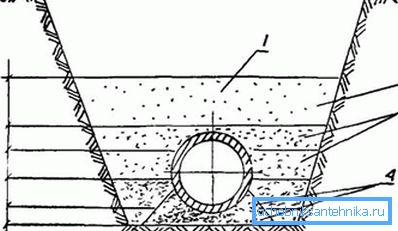
The external sewerage according to the SNiP is filled up according to the following scheme (see illustration):
- The area where tamping is prohibited.
- Place in the upper part where the seal is possible manually.
- The space that requires careful layer-by-layer ramming.
- Cushion compacted with special hand tools.
Assembly process
External sewage can be laid with his own hands. You do not need to have special knowledge and special skills.
We divide the description of the work on the design of the system into several stages:
- The bottom of a previously excavated trench is filled with a layer of sand 150 to 200 mm thick, which is carefully tamped by hand (without using special machines).
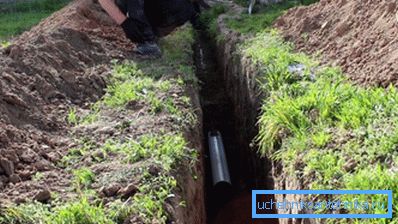
- PVC pipes and orange fittings are used for pipeline installation. All ends and sockets should be thoroughly cleaned from dirt and dust.
- Work should start from the basement of the house and gradually move to the storage well or septic tank. If the internal sewage pipe is brought out, it is enough just to put the socket of the external part on the end. Otherwise, you need to drill the hole, install the connecting pipe and fix it with cement mortar or sealant.
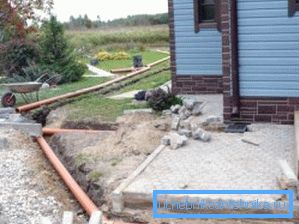
- To connect the elements together, it is enough to insert the smooth end of one of them into the socket of the other. Tightness will ensure that there is a rubber seal. It can be lubricated for reliability with silicone or liquid soap.
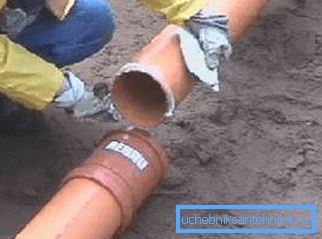
- Attached to the outlet pipe is placed on a sand pillow. Remember that for normal system operation, a slope of 2 cm per meter of pipeline should be observed.

- If it is necessary to change the direction of movement of the sewer pipe, bends are used. Make smooth curves (15, 30 or 45 degrees).
Note! If the length of the drainage system exceeds 12 meters, it is necessary to equip the inspection wells, through which the external sewage system is cleaned. The minimum length between them is 15 meters or at each 90-degree turn.
- In contrast to the internal sewage system, docking should be carried out closely, since the external system is not subject to large thermal expansion.
- United and laid on the bottom of an inclined pipe are poured on the sides of the sand with an intermediate manual tamper. The top layer covering the pipe does not need to be compacted.
- For the insulation of the system, you can use foamed polyethylene. This will avoid freezing sewage in the winter with insufficient deepening of the pipeline.

- From above, the pipe is covered with a layer of sand up to 15 cm thick, then an electric cable is laid in a trench in the corrugation necessary to power the septic tank equipment or the biological cleaning station, after which excavated soil is poured onto the sand.
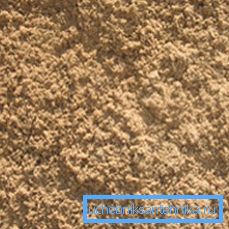
- Remember that over time, the trench will shrink, because it is better to pour the soil with a hill.
Construction of the discharge pipeline
A pipe with a diameter of 160 mm, also laid in a trench, is used to remove the cleaned gutter.
The essence of the work is as follows:
- At the bottom of a previously dug trench piled sand cushion. Then the sand is rammed.
- Pipes are interconnected and laid on the prepared base. Remember that it is also necessary to observe the slope that allows water to flow under the influence of gravity.
- The end of the pipeline is displayed in a special ditch.
- The last stage is pipe filling with sand, which is then covered with previously excavated soil.
Note! Water can only be discharged from a biological treatment station. Only it provides liquid filtration up to 95%, which prevents environmental pollution.
Useful tips
In the design and construction of outdoor sewage, consider the following nuances:
- the number of turns of the pipeline, as well as the joints of various elements and shaped parts should be minimal;
- pipe sockets should be directed towards the flow of water;
- fittings and sockets cannot be shortened;
- It is recommended to fasten a horizontal cord to control the incline of the pipe in the trench.
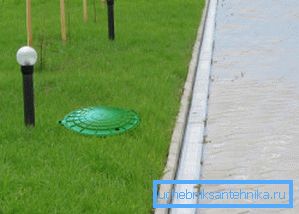
To avoid the formation of ice in the sewer system, it is recommended to warm the pipes. For this, as already mentioned, foam is used. But you can use other materials, including heating electric cable (necessary when the sewer system is laid above the depth of soil freezing).
Conclusion
Outdoor sewage is a very important element of the system of drainage of dirty water. Violations in its operation lead to the inoperability of the entire network, and sometimes to eliminate the problem is very difficult. Therefore, meticulously and carefully approach the implementation of all types of work described above. In more detail about installation of sewer systems it is possible to learn from video in this article.